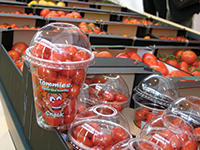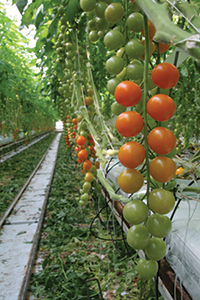
Smart growers keep a constant eye on consumer demand in order to make
the right diversification decisions – and these days, consumers are
showing a growing fondness for mini vegetables.

|
|
| Greenhouse production of mini vegetable crops is growing; the “Tommies” product lineup is big in the Netherlands.
|
Smart growers keep a constant eye on consumer demand in order to make the right diversification decisions – and these days, consumers are showing a growing fondness for mini vegetables.
“Demand has grown steadily for these vegetables during the past decade, and consequently, major shifts have taken place in greenhouse production,” says Dr. Mohyuddin Mirza, of Dr. Mirza Consultants Inc. in Edmonton, Alberta. “For example with mini cucumbers, we’re seeing far more supply now compared to 10 years ago. There are now pickling types and several other small varieties.”
With more minis being grown, Mirza says the amount of regular seedless varieties being grown may decrease. “Supply and demand will determine how greenhouse space is allocated.”
Tomatoes and peppers are the other most noteworthy examples where a major mini-shift has taken place in Canadian greenhouses. “We’ve gone from growing mostly regular beefsteak types of tomatoes to growing smaller fruited clusters, such as cocktail, grape and roma,” notes Mirza. “I also see more production of smaller-sized peppers, including hot peppers.”
CONSUMERS LOVE THEIR CONVENIENCE
The popularity of minis has a lot to do with their convenience, suggests Helene Charlebois, a registered dietician and owner of nutrition and wellness consulting firm HCNutrition in Ottawa. “You can simply throw them in soups and salads and stir fries with minimum preparation,” she says. Charlebois says the nutritional value of minis should be the same as larger varieties, as long as colour and texture are consistent.
She predicts that “with the ease of these smaller versions for growing and less preparation (less cutting), they’ll be a big hit among future generations.”
Cees Vanden Enden believes the speed at which the mini-trend will develop depends on market conditions. “Now that the economy has rebounded, there are more opportunities for production,” says the greenhouse industry consultant based in Water Valley, Alberta. “There is room in the market for new development.”
Mirza doesn’t think interest in minis is concentrated around trendy urban areas like Vancouver and Toronto, either. “It’s a trend in the entire Canadian greenhouse industry,” he says. “It’s human nature to look for new products, and in addition to being novel, mini vegetables offer convenience and smaller portions. Each vegetable variety offers unique benefits in terms of colour, visual appeal and taste.”

|
A GROWING NUMBER OF MINI VARIETIES
“For peppers, most of the greenhouse grown product is the large bell pepper type but there are greenhouses growing some mini bells and some mini ‘long sweets,’” notes Rob Lee, sales manager at MGS Horticultural Inc. (the exclusive distributor of Syngenta’s vegetable seeds in the Canadian and U.S. greenhouse markets).
Syngenta has a number of mini tomato varieties on the market, and is working on breeding new varieties of mini-peppers.
Lee says that in cucumbers, the main greenhouse types include the long English (30 to 40 cm), the mini (12 to 16 cm), and the mini snack type (10 cm). ”There was a significant increase to mini cukes being grown about 10 years ago and production is still significant,” he says.
Syngenta is currently evaluating a number of new varieties of mini cukes for the North American market.
“Products like mini cucumbers and short conical peppers have grown in acreage over the last five years,” agrees Freek Knol, Enza Zaden national sales manager for the U.S. and Canada. He says Enza is a leading supplier for cocktail tomatoes (average fruit size of 30 g) at this time.
Knol adds that his company is researching other offerings in the mini market, but that it’s in a very early stage of doing so.
Danielle Stuart, communications manager at Monsanto Vegetable Seeds, says that “as a vegetable seed company, we’re closely following the developments in the mini segment which is indeed growing.”
De Ruiter Seeds (Monsanto’s protected-culture product brand) offers four mini tomato varieties: ‘Amsterdam’ red plum cherry; ‘Dasher’ red plum cherry for trusses; ‘Juanita’ red cherry for trusses; and ‘Santa Orange’ orange grape tomato.
De Ruiter’s Ministars snack cucumber is suitable for spring, summer and autumn growing seasons or in winter with the addition of artificial light. Ministars have a uniform shape and length (7 to 9 cm) with a good shelf life and an average fruit weight of 40 to 70 grams. Ministars can be grown in umbrella or high-wire growing systems.
Their ‘Jawell’ mini cuke offers early and high production flexible enough for most growing systems. ‘Jawell’ has nicely ribbed dark green fruit of uniform shape and length, and an excellent shelf life. “This mini cucumber averages 15 cm long with a weight of 90-140 grams,” says Stuart. “A short internode length allows this variety to be grown in low greenhouses.”
Minis are available from Rijk Zwaan mainly in sweet pepper, cucumber, tomato and eggplant varieties. “Consumers are demanding taste and convenience along with a good shelf life, and our breeders are responding with new shapes and sizes that offer these qualities,” says spokesperson John DeVries.
The nutrient and temperature regimes of the eggplant crop are somewhat similar to peppers, he notes, while the way of training the plants is more similar to a conventional greenhouse tomato crop. “It is common to graft the eggplants onto a tomato rootstock for long season crops,” adds DeVries.

|
FITTING MORE PLANTS PER SQUARE METRE
With regard to production tips for minis, Vanden Enden observes that growers must make adjustments to be able to harvest enough veggies for a good return. “You have to fit more plants per square metre, and get more volume, but the prices should help with that,” he notes.
Mirza would like to see more government research on mini varieties, but notes that starting years ago, information on minis provided by the seed companies was very useful.
“In order to maintain profitability with these mini veggies, growers should get as much information as possible on topics such as pruning so that higher yields can be obtained,” he says. “Seek out researchers, seed companies and extension people and attend conferences and workshops to prepare yourself for growing these crops.”
When Mirza started to grow more mini cucumbers and cluster tomatoes five years ago, he says his production was not at par with regular cucumbers and beefsteak tomatoes, but now it is quite close, and revenues per square metre are matched.
MORE BREEDING WILL FOCUS ON NUTRITIONAL CONTENT
In terms of other market trends, Mirza thinks growers should expect to see more varieties specifically bred for nutritional content.
“I think the time has come when consumers are going to buy tomatoes for higher lycopene content, cucumbers for different minerals such as selenium, and peppers for their Vitamin C, A and B content,” he notes. “The trend to grow different and diversified vegetables is going to continue and growers should prepare themselves to take advantage of these trends.”
Treena Hein is a freelance writer in Ontario.
Print this page